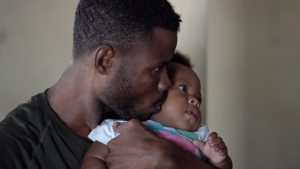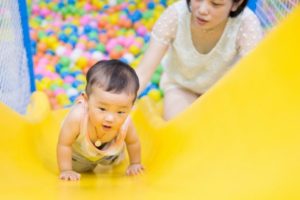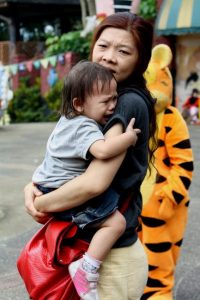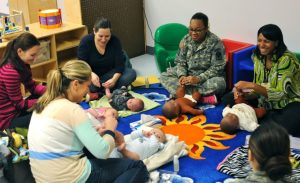6 Social Development in Infancy and Toddlerhood
Chapter Objectives
After this chapter, you should be able to:
- Describe the continuum of development of social skills in infants and toddlers.
- Compare different theories of attachment and attachment styles.
- Explain Erikson’s stage of trust versus mistrust.
- Recognize cultural variations in socialization.
Introduction
The early interactions we have with the adults that care for us as infants and toddlers are very important for the healthy development of social relationships. Let’s examine some of the important interactions in social development during the first two years of life.
Continuum of Development
The Continuum of Development set out in Early Learning for Every Child Today: A framework for Ontario early childhood settings (2007) identifies several root social skills that are emerging in children from birth to approximately 3 years of age (Ontario Ministry of Education, 2014).
Infants (birth to 24 months of age) show emerging interest in social interactions. For example, they prefer human faces over inanimate objects. They will engage with adults by making eye contact, smiling, and reaching their arms out to indicate they want to be picked up. They begin to imitate adult behavior and engage in simple pretend play. Older infants can play simple games that involve taking turns. As they become more mobile, infants become capable of maintaining a social connection when the adult is not physically close by.

Figure 6.1: Father and child social interactions in infancy. (Photo by Zach Vessels on Unsplash)
Toddlers (14 months to 3 years) build on the skills that emerged during infancy and start practicing some new skills. They begin to imitate their peers as well as adults. The ability to see a situation from another’s point of view starts to emerge. This enables toddlers to start to engage in parallel play.

Figure 6.2: Toddlers engaging in parallel play. (Image from Unsplash)
Forming attachments
Attachment is the close bond with a caregiver from which the infant derives a sense of security. The formation of attachments in infancy has been the subject of considerable research as attachments have been viewed as foundations for future relationships. Additionally, attachments form the basis for confidence and curiosity as toddlers, and as important influences on self-concept.

Figure 6.3: The formation of an attachment relationship (Photo by Marcin Jozwiak on Unsplash)
Freud’s Psychoanalytic Theory
According to Freud (1938, as cited in Paris, Ricardo, Raymond, & Johnson, 2021) infants are oral creatures who obtain pleasure from sucking and mouthing objects. Freud believed the infant will become attached to a person or object that provides this pleasure. Consequently, infants were believed to become attached to their mother because they were the one who satisfied their oral needs and provided pleasure. Freud further believed that the infants will become attached to their mothers “if the mother is relaxed and generous in their feeding practices, thereby allowing the child a lot of oral pleasure” (Shaffer, 1985, p. 435, as cited in Paris, Ricardo, Raymond, & Johnson, 2021).
Harlow’s Research
In one classic study, Wisconsin University psychologists Harry and Margaret Harlow investigated the responses of young rhesus monkeys to explore if breastfeeding was the most important factor to attachment.

Figure 6.4: Rhesus monkey sucking its thumb. (Image by splotter_nl is licensed under CC BY 2.0)
Infant monkeys were separated from their biological mothers, and two inanimate surrogate mothers were introduced to their cages. The first inanimate surrogate (the wire mother) consisted of a round wooden head, a mesh of cold metal wires, and a bottle of milk from which the baby monkey could drink. The second Inanimate surrogate was a foam-rubber form wrapped in a heated terry-cloth blanket. The infant monkeys went to the wire “mother” for food, but they overwhelmingly preferred and spent significantly more time with the warm terry-cloth “mother.” The warm terry-cloth “mother” provided no food but did provide comfort (Harlow, 1958, as cited in Paris, Ricardo, Raymond, & Johnson, 2021). The infant’s need for physical closeness and touching is referred to as contact comfort. Contact comfort is believed to be the foundation for attachment. The Harlows’ studies confirmed that babies have social as well as physical needs. Both monkeys and human babies need a secure base that allows them to feel safe. From this base, they can gain the confidence they need to venture out and explore their worlds.
Bowlby’s Theory
Building on the work of Harlow and others, John Bowlby developed the concept of attachment theory. He defined attachment as the affectional bond or tie that an infant forms with the mother. An infant must form this bond with a primary caregiver in order to have normal social and emotional development. In addition, Bowlby proposed that this attachment bond is very powerful and continues throughout life. He used the concept of a secure base to define a healthy attachment between parent and child (Bowlby, 1982, as cited in Paris, Ricardo, Raymond, & Johnson, 2021). A secure base is a parental presence that gives the child a sense of safety as the child explores the surroundings.

Figure 6.5: A mother offering a secure base as their infant plays on a slide. (Image is licensed under CC0)
Bowlby said that two things are needed for a healthy attachment; the caregiver must be responsive to the child’s physical, social, and emotional needs; and the caregiver and child must engage in mutually enjoyable interactions (Bowlby, 1969, as cited in Paris, Ricardo, Raymond, & Johnson, 2021). Additionally, Bowlby observed that infants would go to extraordinary lengths to prevent separation from their parents, such as crying, refusing to be comforted, and waiting for the caregiver to return.

Figure 6.6: This child is seeking comfort from an attachment figure. (Image on Pexels)
Bowlby also observed that these same expressions were common to many other mammals, and consequently argued that these negative responses to separation serve an evolutionary function. Because mammalian infants cannot feed or protect themselves, they are dependent upon the care and protection of adults for survival. Thus, those infants who were able to maintain proximity to an attachment figure were more likely to survive and reproduce.
Erikson: Trust versus Mistrust
As previously discussed in Chapter 1, Erik Erikson formulated an eight-stage theory of psychosocial development. Erikson was in agreement on the importance of a secure base, arguing that the most important goal of infancy was the development of a basic sense of trust in one’s caregivers. Consequently, the first stage, trust versus mistrust, highlights the importance of attachment. Erikson maintained that the first year to year and a half of life involves the establishment of a sense of trust (Erikson, 1982, as cited in Paris, Ricardo, Raymond, & Johnson, 2021). Infants are dependent and must rely on others to meet their basic physical needs as well as their needs for stimulation and comfort. A caregiver who consistently meets these needs instills a sense of trust or the belief that the world is a trustworthy place. The caregiver should not worry about over indulging a child’s need for comfort, contact or stimulation.

Figure 6.7: This baby-wearing father is creating trust with his infant. (Image on Unsplash)

Figure 6.8: Intergenerational relationships and the development of trust. (Image on Unsplash)
Attachment Relationships in Indigenous Families
Parenting styles in Canada’s Indigenous cultures, First Nations, Metis and Inuit, are similar in some ways and differ in other ways. Values held in common include: a holistic approach to development, balance and respect. The Western view of the caregiver-child attachment relationship tends to focus on the child’s primary caregiver. In Indigenous cultures, a child is connected to their immediate family, extended family, community, and ancestors. All of these relationships are seen to be equally important.
Challenges to Establishing Trust
Erikson (1982, as cited in Paris, Ricardo, Raymond, & Johnson, 2021) believed that mistrust could contaminate all aspects of one’s life and deprive the individual of love and fellowship with others. Consider the implications for establishing trust if a caregiver is unavailable or is upset and ill-prepared to care for a child. Or if a child is born prematurely, is unwanted, or has physical differences that make them more challenging to parent. Under these circumstances, we cannot assume that the parent is going to provide the child with a feeling of trust.
The residential school system and the child protection system in Canada have had a profound and long-lasting effect on Indigenous people. Children who were removed from their families and raised in foster care or a residential school have become parents and grandparents. As children, they were subject to abuse, loss and trauma. As a result of this trauma, they are more likely to have difficulty forming healthy attachments as adults (Hardy & Bellamy, 2013).
Mary Ainsworth and the Strange Situation
Developmental psychologist Mary Ainsworth, a student of John Bowlby, continued studying the development of attachment in infants. Ainsworth and colleagues created a laboratory test that measured an infant’s attachment to their parent. The test is called The Strange Situation because it is conducted in a context that is unfamiliar to the child and therefore likely to heighten the child’s need for their parent (Ainsworth, 1979, as cited in Paris, Ricardo, Raymond, & Johnson, 2021).

Figure 6.9: An infant crawling on the floor with toys around as done in the Strange Situation. (Image is in the public domain)
During the procedure, which last about 20 minutes, the parent and the infant are first left alone, while the infant explores the room full of toys. Then a strange adult enters the room and talks for a minute to the parent, after which the parent leaves the room. The stranger stays with the infant for a few minutes, and then the parent again enters and the stranger leaves the room. During the entire session, a video camera records the child’s behaviours. Which are later coded by the research team. The investigators were especially interested in how the child responded to the caregiver leaving and returning to the room, referred to the “reunion”. On the basis of their behaviours, the children are categorized into one of four groups where each group reflect a different kind of attachment relationship with the caregiver. One style is secure and the other three styles are referred to as insecure.
- A child with a secure attachment style usually explores freely while the caregiver is present and may engage with the stranger. The child will typically play with the toys and bring one to the caregiver to show and describe from time to time. The child may be upset when the caregiver departs but is also happy to see the caregiver return.
- A child with an ambivalent (sometimes called resistant) attachment style is wary about the situation in general, particularly the stranger, and stays close or even clings to the caregiver rather than exploring the toys. When the caregiver leaves, the child is extremely distressed and is ambivalent when the caregiver returns. The child may rush to the caregiver, but then fails to be comforted when picked up. The child may still be angry and even resist attempts to be soothed.
- A child with an avoidant attachment style will avoid or ignore the mother, showing little emotion when the mother departs or returns. The child may run away from the mother as they approach the child. The child will not explore very much, regardless of who is there, and the stranger will not be treated much differently from the mother.
- A child with a disorganized/disoriented attachment style seems to have an inconsistent way coping with the stress of the strange situation. The child may cry during the separation, but avoid the mother upon return. Or the child may approach the mother but then freeze or fall to the floor.
How common are attachment styles among children? In Canada, attachment disorders are uncommon in the general population (under 1%). That increases to possibly 40% for children who are exposed to gross maltreatment or poor-quality institutionalization (Atkinson & Beiser, 2016).
Keep in mind that methods for measuring attachment styles have been based on a model that reflects middle-class, Western values. New methods for assessing attachment styles involve using a Q-sort technique in which a large number of behaviours are recorded on cards and the observer sorts the cards in a way that reflects the type of behavior that occurs within the situation (Waters, 1987, as cited in Paris, Ricardo, Raymond, & Johnson, 2021). There are 90 items in the third version of the Q-sort technique, and examples of the behaviors assessed include:
- When the child returns to the mother after playing, the child is sometimes fussy for no clear reason.
- When the child is upset or injured, the child will accept comfort from adults other than the mother.
- Child often hugs or cuddles against the mother, without the mother asking or inviting the child to do so.
- When the child is upset by their mother’s leaving, the child continues to cry or even gets angry after the mother is gone.
At least two researchers observe the child and parent in the home for 1.5-2 hours per visit. Usually, two visits are sufficient to gather adequate information. The parent is asked if the behaviors observed are typical for the child. This information is used to test the validity of the Strange Situation classifications across age, cultures, and with clinical populations.
Caregiver Consistency
Having a consistent caregiver may be jeopardized if the infant is cared for in a child care setting with a high turnover of staff or if institutionalized and given little more than basic physical care.
Infants who, perhaps because of being in orphanages with inadequate care, have not had the opportunity to attach in infancy may still form initial secure attachments several years later. However, they may be more likely to experience depression and anger or be overly friendly as they interact with others (O’Connor et. al., 2003, as cited in Paris, Ricardo, Raymond, & Johnson, 2021).
Social Deprivation
Severe deprivation of parental attachment can have serious consequences for development across developmental domains. According to studies of children who have not been given warm, nurturing care, they may show developmental delays, failure to thrive and attachment disorders (Bowlby, 1982, as cited in Paris, Ricardo, Raymond, & Johnson, 2021). Non-organic failure to thrive is the diagnosis for an infant who does not grow, develop, or gain weight on schedule. In addition, postpartum depression can cause even a well-intentioned mother to neglect their infant.
Reactive Attachment Disorder
Children who experience social neglect or deprivation, repeatedly change primary caregivers that limit opportunities to form stable attachments, or are reared in unusual settings (such as institutions) that limit opportunities to form stable attachments can certainly have difficulty form attachments. According to the Diagnostic and Manual of Mental Disorders, 5th edition (American Psychiatric Association, 2013) those children experiencing neglectful situations and also displaying markedly disturbed and developmentally inappropriate attachment behaviour, such as being inhibited and withdrawn, minimal social and emotional responsiveness to others, and limited positive affect, may be diagnosed with Reactive Attachment Disorder. This disorder often occurs with developmental delays, especially in cognitive and language areas. Fortunately, the majority of severely neglected children do not develop Reactive Attachment Disorder, which occurs in less than 10% of such children. The quality of the caregiving environment after serious neglect affects the development of this disorder.
Resiliency
Being able to overcome challenges and successfully adapt is resiliency. Even young children can exhibit strong resilience to harsh circumstances. Resiliency can be attributed to certain personality factors, such as an easy-going temperament. Some children are warm, friendly, and responsive, whereas others tend to be more irritable, less manageable, and difficult to console, and these differences play a role in attachment (Gillath, Shaver, Baek, & Chun, 2008; Seifer, Schiller, Sameroff, Resnich, & Riordan, 1996, as cited in Paris, Ricardo, Raymond, & Johnson, 2021). It seems safe to say that attachment, like most other developmental processes, is affected by an inter play of genetic and socialization influences.
Receiving support from others also leads to resiliency. A positive and strong support group can help a parent and child build a strong foundation by offering assistance and positive attitudes toward the newborn and parent. In a direct test of this idea, Dutch researcher van den Boom (1994, as cited in Paris, Ricardo, Raymond, & Johnson, 2021) randomly assigned some babies/mothers to a training session in which they learned to better respond to their children’s needs. The research found that these mothers’ babies were more likely to show a secure attachment style in comparison the other mothers in a control group that did not receive training (Lally & Valentine-French, 2019).

Figure 6.10: This infant massage class for new mothers could provide training and support for mothers. (Image is in the public domain)
Cultural Variations
The term culture refers to all of the beliefs, customs, ideas, behaviours, and traditions of a particular society that are passed through generations. Culture is transmitted to people through language as well as through the modeling of behaviour, and it defines which traits and behaviours are considered important, desirable, or undesirable.
Some cultural differences in attachment styles have been found (Rothbaum, Weisz, Pott, Miyake, & Morelli, 2010, as cited in Paris, Ricardo, Raymond, & Johnson, 2021). For example, German parents value independence and Japanese mothers are typically by their children’s sides. As a result, the rate of insecure-avoidant attachments is higher in Germany and insecure-resistant attachments are higher in Japan. These differences reflect cultural variation rather than true insecurity (Van Ijzendoorn and Sagi, 1999, as cited in Paris, Ricardo, Raymond, & Johnson, 2021).
A research study of development among Indigenous children in Canada, conducted by Findlay, Kohen and Miller (2014), concluded that the age range for the development of certain skills, including social skills, can be different for Indigenous children compared to the general population. For example, the cultural norm in some Indigenous identity groups of living with extended family members may influence the development of certain social skills by providing additional support and modelling behaviour. The study also found variations between Indigenous identity groups (Metis, Inuit and off-reserve First Nations) in expectations for children to develop independent behaviours. The researchers emphasized the importance of using culturally specific age ranges and interventions because using those based on the general population might result in over or under identification of children at risk for developmental delays. (Findlay, Kohen, & Miller, 2014).
Summary
References
Atkinson, L. & Beiser, M. (Eds.). (2016). Attachment disorders. In caring for kids new to Canada. Retrieved from https://kidsnewtocanada.ca/mental-health/attachment-disorders
Findlay, L., Kohen, D., & Miller, A. (2014). Developmental milestones among Aboriginal children in Canada. Paediatrics & child health, 19(5), 241–246. https://doi.org/10.1093/pch/19.5.241).
Hardy, C. & Bellamy, S. (Eds). Caregiver-infant attachement for aborigional families. Retrieved from https://www.ccnsa-nccah.ca/docs/health/FS-InfantAttachment-Hardy-Bellamy-EN.pdf
Lally, M. & Valentine-French, S. (2019). Lifespan development: A psychological perspective (2nd ed.). Retrieved from http://dept.clcillinois.edu/psy/LifespanDevelopment.pdf
Ontario Ministry of Education. (2014). Excerpts from “Elect”. Retrieved from https://www.dufferincounty.ca/sites/default/files/rtb/Excerpts-from-Early-Learning-for-Every-Child-Today.pdf

